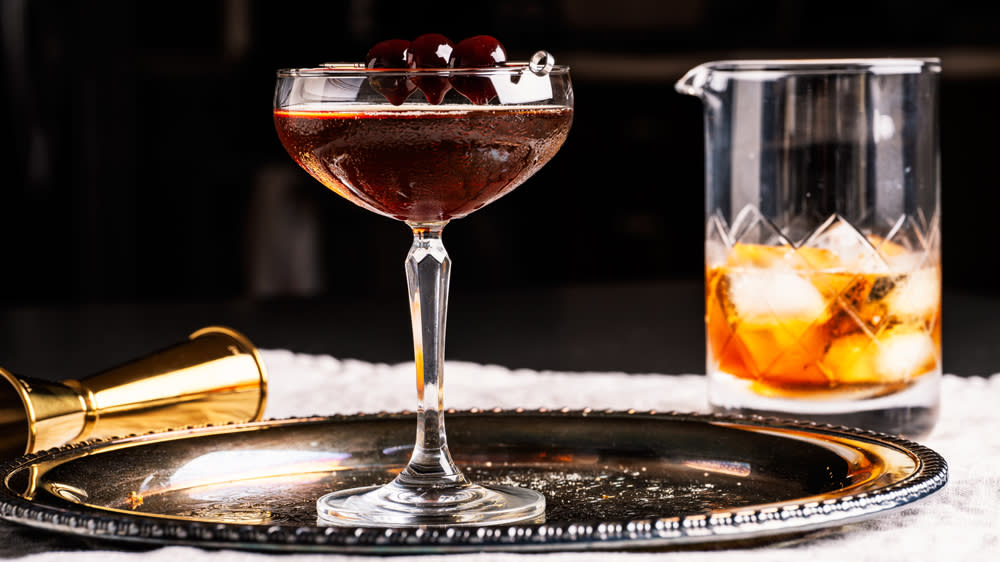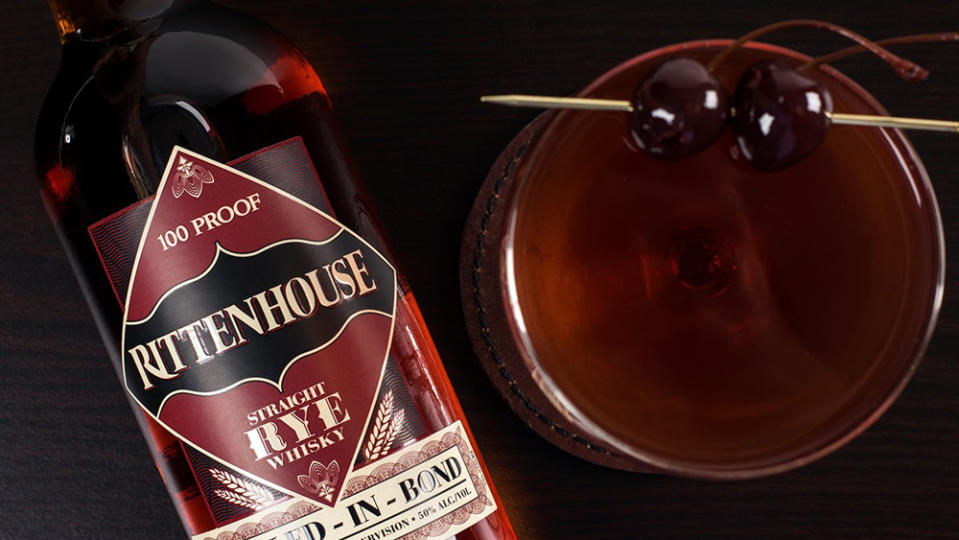How to Make a Black Manhattan, a Rule-Breaking Twist on the Classic Whiskey Cocktail

If you purchase an independently reviewed product or service through a link on our website, Robb Report may receive an affiliate commission.
The Black Manhattan is like a Manhattan, but more so. It takes the energy of a normal Manhattan cocktail—no one’s idea of a shrinking violet, I think you’d agree—and supercharges it. If the standard Manhattan is a song played on a piano, the Black Manhattan is that same song on a pipe organ—big, booming chords of flavor, filling every available space.
More from Robb Report
Why Your Favorite Bar May Start Pouring You a Cocktail on Tap
Michter's Is Releasing Its Barrel Strength Rye for the First Time in Two Years
Why the Coolest Bar in Town Might Just Be at Your Tailor's Shop
Most Manhattan variations follow a simple template: You take the standard recipe for the Manhattan (2 oz. whiskey, 1 oz. sweet vermouth, 2 dashes bitters), and reduce the vermouth by half and accent it with a small pour of some other liqueur. There are lots of these: Use Cynar and it’s a Little Italy; Maraschino and it’s a Red Hook; Benedictine for a Fort Point; you can go on and on. The Black Manhattan does not follow this rule, because when Todd Smith thought up the cocktail in 2005, the rule hadn’t been invented yet.
Well, 2005 wasn’t that long ago, but in mixology terms, it’s practically a lifetime. All the templates and cocktail families and best practices that everyone now knows and takes for granted were, at the beginning of George W. Bush’s second term, still being formed. What this means for the Black Manhattan is not only that it is a Manhattan in which the sweet vermouth is not reduced but fully supplanted with an ounce of the Italian bittersweet liqueur, Averna (the aforementioned rule-breaking) but also, it means that the online recipes are kinda all over the place, because the conception of a Manhattan in 2005 was different to what it is today.
Todd Smith invented the Black Manhattan when he was working at a restaurant called Cortez in San Francisco, but it wasn’t until the next year, when Smith went on to open the celebrated Bourbon & Branch, that the cocktail started getting the attention it deserved. At the time, rye whiskey was practically an endangered species (“we spill more bourbon in a day than we sell rye in a year,” said one of the Kentucky’s biggest distilleries in 2007) so by and large, Manhattans were made with bourbon.
What’s more, Smith was into making his own bitters (something most people don’t do anymore), so the Black Manhattan as it first appeared on the Bourbon & Branch menu was bourbon, Averna, and a couple dashes of a house-made cherry coffee bitters. Over the years, though, as rye whiskey had a renaissance and it became generally accepted that rye makes a superior Manhattan, the Black Manhattan evolved as well. People remembered that it’s a Manhattan with Averna but forgot the original spirit and bitters. This is why in online recipes, sometimes you see bourbon and sometimes rye, sometimes Angostura bitters, sometimes orange bitters, sometimes both. All over the place.
Another truth about the Black Manhattan is that these are all pretty good. I made every recipe I could find and tried them side-by-side, and it was earnestly difficult to choose a favorite. Like the Revolver (another dark whiskey cocktail made famous at Bourbon & Branch), this is good no matter what you do to it, which is one of the reasons it has managed to endure through its evolutions. Averna doesn’t taste like it would be interchangeable with sweet vermouth, but the Black Manhattan works like it is. It tastes like the original, just darker and fuller, with more cocoa and coffee and cola notes. Like a Manhattan, but more so.
Black Manhattan
2 oz. rye whiskey
1 oz. Averna
2 dashes Angostura Bitters
Add all ingredients to a mixing glass with ice and stir for 10 to 15 seconds (on small ice) or 20 to 30 seconds (on big ice). Strain up into a coupe or cocktail glass, and garnish with a cherry.
NOTES ON INGREDIENTS

Whiskey: As mentioned, this is outstanding across categories. It’s great with the Kentucky-style ryes, but also with the Canadian-style ryes. It’s great with bourbon. I tried it with Bulleit Whiskey’s new American Single Malt and it was fantastic, with bright fruit and alluring spice, but I think my favorite is still a rye. As for styles, I honestly can’t choose. With a higher proof Kentucky rye, like Rittenhouse or Wild Turkey 101, you get a stout little cocktail, with enough whiskey backbone to stand up to the richness of the Averna. With an all- or mostly rye bottle, like Dickel Rye or Redemption, you get herbaceousness and spice from the grains that’s lovely. You really can’t lose; go whichever way you like.
Averna: An “amaro” is an Italian bittersweet liqueur, designed to either rouse the appetite (aperitivo) or aid digestion (digestivo), depending on the proof. There are hundreds of brands of amari. Averna is one of the most popular, more toward the digestivo side at 29 percent alcohol, and made in Sicily since 1868. The Black Manhattan requires it.
To be inescapably clear: Some recipes for this drink will claim that you can use a different amaro for this, and they’re flat wrong. You can replace part of the vermouth with different amaro and be OK, but Averna is the only amaro I’ve tried (and I’ve tried a bunch) that can function as a full and complete vermouth replacement.
With a robust rye whiskey, use a full ounce, as the above recipe indicates. If you’re grabbing a bourbon (which comes off sweeter than rye) or a rye 90 proof or lower, you might want to lower the Averna to 0.75 oz., or even 0.5 oz., depending on taste.
Bitters: I’ll never understand how orange bitters made their way into this drink. It’s fine with orange bitters, but it’s not better. Skip them. I think a couple dashes of Angostura is all you need.
That said, when Smith moved on from Bourbon & Branch and the staff ran out of his proprietary cherry coffee bitters, they just switched to Fee Brothers Barrel Aged Old Fashioned Bitters, which amplifies the baking spice notes. I personally haven’t had an opportunity to try this yet, but at least one of the old Bourbon & Branch bartenders from back in those days insists it’s the best way to make it, so take that for what it’s worth.
Best of Robb Report
Why a Heritage Turkey Is the Best Thanksgiving Bird—and How to Get One
The 10 Best Wines to Pair With Steak, From Cabernet to Malbec
Sign up for Robb Report's Newsletter. For the latest news, follow us on Facebook, Twitter, and Instagram.

